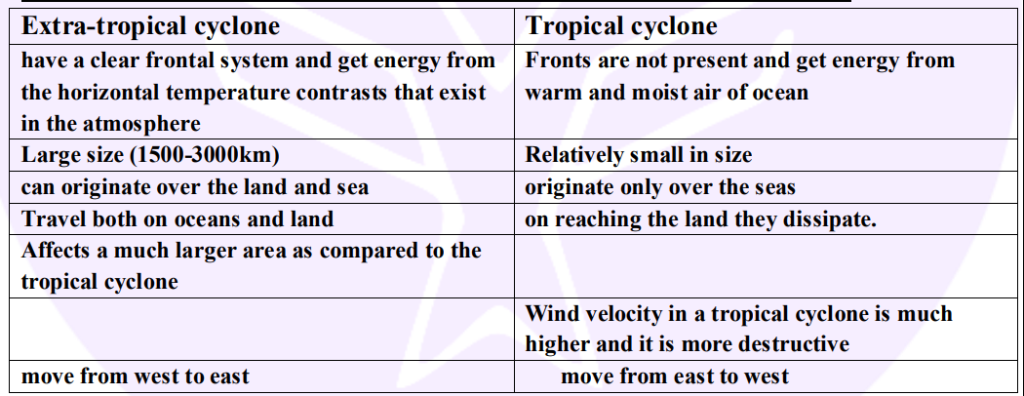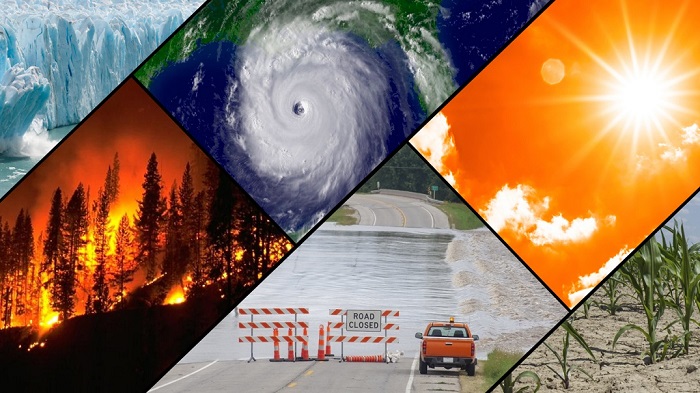World Geography : Cyclone & its Types & Characteristics and Climate Change ( UPSC )
Cyclone
- It is an area of low-pressure area with winds spiraling inwards.
- Cyclones rotate anti-clockwise in Northern Hemisphere and rotate clockwise in Southern Hemisphere.
- The process of Cyclone formation and intensification is called Cyclogenesis.
Types of Cyclones
- Temperate or mid-latitude cyclones
Stages of Cyclogenesis
Stage A
- the first stage involves the convergence of two air masses of contrasting physical properties and direction.
Stage B
- It is called „incipient stage‟ during which the warm and cold air masses penetrate into the territories of each other.
Stage C
- It is mature when the cyclone is fully developed and isobars become almost circular.
Stage D
- Warm sector is narrowed in extent due to advancement of cold front at a faster rate than a warm front, and cold front comes nearer to warm front.
Stage E
- This stage starts with the occlusion of cyclone when the advancing cold front finally overtakes the warm front and occluded front is formed.
Stage F
- In the final stage, warm sector completely disappears, occluded front is eliminated and ultimately cyclone dissipate.
Characteristics of Temperate Cyclone
- Dynamic in Origin
- Latitudinal extension 35 -65 degree
- Formation is due to frontogenesis
- Its can forms on both seas as well as land.
- They cover a larger area. Typical size: 300 – 2000 kms in diameter
- Inverted “V‟ shaped
- Energy depends on the thermal contrast of the air masses
- Formation occurs in both winter and summer but in winter it is more active.
- Rainfall is slow and continues for many days, sometimes even weeks.
- It affects the western coasts of the continents, driven by westerly winds.
- Their direction of propagation is towards the poles
- Non-destructive in nature.
- Move at a gentle pace of 5-25km per hour
- The isobars are elliptical in shape
- Lifespan is 1 to 2 weeks
Tropical or low latitudinal cyclone
- In the western North Atlantic, central and eastern North Pacific, Caribbean Sea, and the Gulf of Mexico, such a weather phenomenon is called “hurricanes“
- In the western North Pacific, it is called “typhoons“
- In the Bay of Bengal and the Arabian Sea, it is called “cyclones”
The conditions favourable for the formation and intensification of tropical storms are
- Large sea surface with temperature higher than 27° C
- Presence of the Coriolis force
- Small variations in the vertical wind speed
- A pre-existing weak low-pressure area or low-level-cyclonic circulation
- Upper divergence above the sea level system
Structure of Tropical cyclone
- Eye
- It is the center of cyclone around which strong spirally winds circulate in a mature tropical cyclone.
- It is a region of calm with subsiding air.
- Eye Wall
- There is a strong spiraling ascent of air to greater height reaching the tropopause.
- The wind reaches maximum velocity in this region, reaching as high as 250 km per hour.
- Torrential rain occurs here.
- From the eye wall rain bands may radiate and trains of cumulus and cumulonimbus clouds may drift into the outer region
- The diameter of the circulating system can vary between 150 and 250 km
- The diameter of the storm over the Bay of Bengal, Arabian Sea and Indian Ocean is between 600 – 1200 km.
- The system moves slowly about 300 – 500 km per day.
Characteristics of Tropical Cyclone
- Thermal in Origin
- Confined to 10 – 30 Degree N and S of equator
- Tropical cyclones do not form between 5 Degree N-5 Degree S, because the effect of Coriolis is negligible
- Formation is possible only on water, where temperatures is on average 27 Degree C
- The isobars are generally circular, and close to each other resulting into steep pressure gradient.
- They do not have fronts
- They derive their energy from the latent heat
- The clouds in the cyclone are cumulonimbus having vertical extension up to about 12- 15km.
- They give torrential rainfall.
- Majority of tropical cyclones decay when they come over the land or when they recurve northward over oceans
- Maximum rainfall is in the eye wall , while the eye is an inert and quiet area.
- Driven by trade winds, affects the eastern coasts of continents.
- The direction of transmission of cold is only towards the poles because the direction of Coriolis is the same, so the moment of force is the same
- Destroyer in nature
- Speed – 120-420 km/ hour.
- Life span is 24-48 hours
- Limited to small area.Typical size: 100 – 500 kms in diameter
Naming of Cyclones
- Cyclones that form in every ocean basin across the world are named by the regional specialized meteorological centers (RSMCs) and Tropical Cyclone Warning Centres (TCWCs).
- There are six RSMCs in the world, including the India Meteorological Department (IMD), and five TCWCs.
Difference between extra-tropical cyclone and tropical cyclone

Anticyclone
- An anti-cyclone also known as a high pressure area is a large atmospheric circulation system with the wind flowing clockwise around it in the Northern Hemisphere, an counter-clockwise in the Southern Hemisphere.
- The sinking air spreads out when it reaches the ground, producing a divergence at the surface
- Anticyclones produce a stable atmosphere.
Climate Change
The change in the average weather conditions of a place with time is called climate change.
Responsible factors
A- Natural factors
- The following natural phenomena are responsible for climate change.
- Plate Tectonics
- According to plate tectonics theory , climate change occurs in those parts due to the displacement of plates.
- Changes in Earth’s Orbit
- Climate change is caused by changes in the location of the Earth’s axis, inclination on the axis, etc.
- Change in the number of sun spots
- The number of solar spots changes every 11 years, which leads to climate change.
- Volcano
- During the eruption of a volcano, a large amount of heat is released.
Anthropogenic (Human Caused) Factors
- Combustion of fossil fuels (coal, petrol)
- Deforestation
- Lack of waste Management
- Shifting cultivation.
- Encroachment on wetlands
- Animal Husbandry
- Use of Nitrogenous Fertilizers
Effects of climate change
A. Global warming
- Global warming is a gradual increase in the earth’s temperature generally due to the greenhouse effect caused by greenhouse gasses.
The main greenhouse gases
- Water vapor
- It is the most abundant greenhouse gas (GHG), however it spends just a short time in the atmosphere
- The amount of water vapor varies drastically with time, region and altitude.
- It is not considered the most important GHG.
- Carbon dioxide (CO2)
- It is the most important GHG and is produced both naturally and through human activities.
Natural sources of CO2
- Volcanic eruptions
- Animal respiration.
Anthropogenic sources
- Deforestation
- Burning of fossil fuels for energy
3. Methane
- The large sources of Methane come from the decomposition of organic matter e.g. in landfills and in agriculture and from the digestion of ruminants (cows, goats etc).
- It is a stronger GHG than CO2 because it can absorb more heat.
- However it is much less abundant in the atmosphere.
4. Nitrous oxide
- It is considered as a very powerful greenhouse gas which is abundantly produced in the agriculture sector, specifically in the production and use of organic fertilizers
- It is also produced when burning fossil fuels.
5. Chlorofluorocarbons (CFCs)
- These man-made compounds were produced for industrial use, mainly in refrigerants and air conditioners.
Effects of Global warming
A. Global Warming
- Increased levels of melting of glaciers
- The melting of glaciers will caused flooded the rivers dependent on them
- The release of the stored CO2 in them will further increase global warming.
- Sea level will rise
- Impact on marine ecosystem
- Due to global warming, sea water temperature will increase resulting in migration of organisms towards the poles.
- Expansion/dispersion of sea water will lead to the submergence of towns, countries and islands situated on the coast, resulting in migration of human being.
- Rise in sea water temperature will lead to coral bleaching while rise in sea level will submerge mangroves.
- Acidity will inhibit the formation of calcium carbonate which adversely affect the calcification process
- Loss of biodiversity
- Species are not displaced quickly at the time of climate change, which has threatened their existence
- Decreased agricultural productivity
- Agricultural productivity will decreased by 25-30 % due to increase in 10 C temperature in tropical areas.
- However, agricultural productivity will increase in higher latitudes
- Increase in extreme weather events
- Due to global warming, the intensity and frequency of natural disasters like floods, droughts, cyclones will increased.
- Impact on human health
- Due to global warming, the outbreak of heat wave is increasing.
- In 2019, 184 people have died in Bihar alone.
- If the increase in global temperature continues like this, then their outbreak can increase 2000 times.
- Global warming will lead to increase in communicable diseases like malaria, dengue etc.
- Political struggle
- Due to global warming, water resources will be scarce in quantity, which will increase conflicts between countries (over international rivers) and between states over inter-state rivers.
- Economic Losses
- Research says that if no action is taken to curtail the global carbon emissions, climate change could cost between 5 and 20 percent of the annual global gross domestic product.
B. Acid Rain
- When the oxides of sulfur and nitrogen react with the moisture of the atmosphere, then rain with less than 5.6 °C is called acid rain.
Sources of sulfur
- Natural resources
- Volcanic Eruption
- Decomposition of organic matter
- Seas and Oceans
- Anthropogenic sources
- Sulfur recovery from coal combustion
- 30 percent from combustion of petroleum
- Remaining sulfur ore from manufacturing of H2SO4 and fertilizer industry
Sources of nitrogen
- Natural resources
- Lightning, Volcanic eruptions, Biological activities
- Anthropogenic sources
- Combustion of fossil fuels, Dawagin/Davanal (forest fire), Fertilizer industry
Effects of Acid Rain
- On humans
- Skin irritation
- low visibility
- difficulty in breathing
- carcinogenic food poisoning.
- Earlier ageing.
- On other organisms
- Color blindness of trees and animals.
- On soil
- Infertility of soil due to leaching of nutrients.
- On marine ecosystem
- Damage to the Shell of animal’s eggs.
- Acidification of the Oceans and Seas.
Acidification of oceans
- The decrease in the surface of water due to increase in the amount of carbon dioxide in the ocean water is called acidification of the oceans.
Effects:
- The process of calcination slows down.
- Due to the impact of the seafood chain, the fish industry is affected.
- Coral bleaching
Effect on microorganisms:
- Decreased activity of microorganisms
- Decreased rate of decomposition of dead organisms
- Decreased soil fertility due to lack of organic matter
Effects on buildings, monuments and materials
- Adversely affected.
- Limestone, marble gets destroyed and yellow color starts to climb.
Ozone depletion
- The layer of ozone gas is found at an altitude of 25-30 km in the stratosphere level of the atmosphere.
- It prevents the harmful ultraviolet rays of the sun from reaching the earth, thereby protecting us from the dangers of skin cancer etc.
- Generally, the formation and dissolution of ozone remains in 2 equilibrium, but due to ozone depleting substances, the rate of ozone decomposition has exceeded the rate of its formation.
- This is called ozone depletion.
- It was first observed in 1985 over Antarctica where the amount of ozone was reduced to 50 percent of the actual amount .
Major ozone depleting substances
CFC (Chloro Fluoro Carbon)
- Chemically stable
- Inflammable
- Being non-toxic, it is used in refrigerators, ACs, foams.
- It’s life span is 40-150 years.
- When the vapor reaches the atmosphere, then its Chlorine molecule is released under the influence of Ultraviolet rays.
- This free chlorine molecule reacts with ozone to form Chlorine monoxide
Other ozone-depleting substances (ODS)
- Hydrochlorofluorocarbons (HCFCs)
- Halons
- Methyl bromide
- Carbon tetrachloride
- Methyl chloroform.
Effect of polar stratosphere clouds
- Polar stratosphere clouds are found at an altitude of 50-60 km above the poles.
- Chlorine reacts with Methane in the upper atmosphere and converts to Chlorine nitrate by reacting with nitrogen dioxide.
- The polar stratosphere acts as their storage, due to which the depletion of ozone is enhances.
Effect of ozone depletion
- Skin cancer, Eye diseases, Respiratory diseases
- Inhibition of growth and development in plants
- Decreased life span of phytoplankton.
- Increase in concentration of Hydrogen peroxides (H2O2) in air.
International efforts to stop climate change
United Nations Enviremetal Programme
- It was established in 1972 at the Stockholm Conference (Sweden).
- Headquarter – Nairobi, Kenya
- Its main function is to coordinate programs related to sustainable development within the United Nations system.
It’s work areas:
- Climate Change
- Disaster and Conflicts
- Ecological Management
- Environmental governance
- Environment under review
- Harmful substances
- Efficient use of resources
Inter Governmental Pannel On Climate Change
- It was established in 1988 by UNEP and WMO (World Meteorological Organization).
- It’s main function is to publish research and journals related to climate change around the world.
UNFCC (United Nation Framework Convention On Climate Change)
- It was founded in 1992 in Rio-de Janeiro, Brazil.
- It was signed in June 1992 and came into force in 1994.
- It‟s main objective is to control human-caused emissions of greenhouse gases in the atmosphere
- It has 197 parties
- Every year of these parties organize a meeting since 1995 which is called COP (Conference of Parties)
It has 6 major work areas:
- Energy Conservation
- Climate financing
- Industry Transition
- Nature Based Solutions
- Action at the City and Local Level
- Flexibility
It covers following major agreements:
Kyoto Protocol
- This was approved in COP-3 in 1993.
- It was signed by India in 2002 and is in force since 2005.
- This agreement mentions 2 commitment periods
- 2008-2012
- In this period, the emission of 6 greenhouse gases (CO2, water vapor, CH4, N2O, HFC,PFC,SF6) is to be reduced by 5 % from 1990 levels.
- USA never signed the Kyoto Protocol, while Canada withdrew in 2012.
- 2013-2020
- It was implemented after the Doha Round of 2012.
- It has set a target of reducing the greenhouse level of 1990 by 20 % till 2020
- Russia, Japan and New Zealand did not sign it
- It included 7 green house gases – CO2, water vapor, CH4, N2O, HFC,PFC,SF6,NF3
Mechanisms of Kyoto Protocol
- Carbon trading
- When a developed (Annexure) country exceeds their emission limit, then they have to buy carbon credits.
- One ton of carbon is called one carbon unit.
- Clean Development Management
- In this, a developed (Annex) country helps in reducing greenhouse gas emissions of a developing or underdeveloped country (Non- Annex).
- Joint Implementation
- When a developed (annex) country helps another developed (annex) country to reduce it’s greenhouse gas emissions.
Paris Agreement
- Agreement on Green House Gases was signed in Paris, France during COP- 21 in 2015.
- It was signed by 175 countries in New York on 22 April 2016.
- It came into effect from 4th November 2016.
- It will replace the Kyoto Protocol on 31 January 2020.
Major Provisions
- The target has been set to keep the average global temperature at 2 Degree C above pre-industrial temperatures and 1.5 Degree C, if possible, by the end of the 21st century.
- In this, agreement while the provisions of historical responsibility eliminated
- The provision of common but differentiated responsibility (CBDR) was included.
- In this, each country has to declare its own commitment, which is called Intended Nationally Determined Contributions (INDCs)
India’s INDCS
- Reduction of greenhouse gas emissions from 2005 by 33-35 % by 2030.
- By 2030, 40% of the total energy generated from renewable sources
- Collection of 2.5 to 3 billion tones of CO2 by 2030 through afforestation.
Major convention for the protection of the ozone layer
- Vienna Agreement
- It was held in Vienna in 1985
- This conference pave the way of Montreal Protocol.
- Montreal Protocol
- It was held in Montreal, Canada in 1987
- It’s main goal was to eliminate 100% in a phased manner by 2010 the use of Chlorofluorocarbons, Halons and other Ozone depleting substances.
- It was successful in achieving it’s goal.
- Kigali Agreement
- The agreement for the next round of the Montreal Protocol was signed in Kigali (Rwanda) in 2016
- It has come into force on 01 January 2019 in place of Montreal.
- It aims to eliminate hydrofluorocarbons by 2040
National Action Plan on Climate Change (NAPCC)
- The National Action Plan on Climate Change (NAPCC) was launched in 2008 by the Prime Minister’s Council on Climate Change.
- It aims at creating awareness among the representatives of the public, different agencies of the government, scientists, industry and the communities on the threat posed by climate change and the steps to counter it.
- There are 8 national missions forming the core of the NAPCC which represent multi-pronged, long term and integrated strategies for achieving key goals in climate change. These are:
- National Solar Mission
- National Mission for Enhanced Energy Efficiency
- National Mission on Sustainable Habitat
- National Water Mission
- National Mission for Sustaining the Himalayan Ecosystem
- National Mission for A Green India
- National Mission for Sustainable Agriculture
- National Mission on Strategic Knowledge for Climate Change
- National Solar Mission
- The program was inaugurated in 2010 with a target of 20GW by 2022.
- It was later increased to 100 GW (100,000 MW) in 2015.
- MNRE has proposed to achieve 60 GW from large and medium scale solar projects, and 40 GW through rooftop solar projects.
- Committed to Nationally Determined Contributions (Paris Accord), India made a pledge that by 2030, 40% of installed power generation capacity shall be based on clean sources.
- It was determined that 175 GW of renewable energy capacity will be installed by 2022.
- This includes 100 GW from solar, 60 GW from wind, 10 GW from bio-power and 5 GW from small hydro power.
- National Mission for Enhanced Energy Efficiency
- NMEEE includes four specific energy efficiency initiatives:
- Perform achieve and Trade
- Market transformation for energy efficiency
- Energy efficiency financing platform
- Framework for Energy efficiency Economic development
- NMEEE includes four specific energy efficiency initiatives:
- National Mission on Sustainable Habitat
- Approved in 2010
- National Water Mission
- This mission was launched in 2011
- Objective – increase water use efficiency by 20%
- National Mission for Sustaining the Himalayan Ecosystem
- It was launched in 2010 but was formally approved by the government in 2014.
- Objective of NMSHE:
- Develop in a time-bound manner a sustainable national capacity to continuously assess the health status of the Himalayan ecosystem
- Assist states in the Himalayan region with the implementation of actions selected for sustainable development.
- Objective of NMSHE:
- It was launched in 2010 but was formally approved by the government in 2014.
- National Mission for A Green India
- Objectives of Green India Mission (GIM)
- Growth in forest or tree cover to 5 million hectares (mha) and increase the quality of forest cover in another 5 million hectares of forest or non-forest lands. There are separate sub-targets for a variety of forests and their ecosystems namely, grassland, dense forest, wetland etc.
- Increase the quality of degrading moderately dense forests – 1.5 million hectares (ha)
- Ecologically restore open forests which are being degraded – 3 million hectares (ha)
- Grasslands revival – 0.4 million hectares
- Wetlands revival – 0.10 million hectares
- Ecological restoration of shifting cultivation areas, mangroves, scrub, ravines, cold deserts, & abandoned mining areas – 1.8 million hectares with different sub-targets.
- Increase in forest cover in urban areas and its outskirts – 0.20 million hectares
- Increase in forest and tree cover on marginal agricultural lands/fallows and other non-forest lands which comes under agroforestry – 3 million hectares.
- Increase in forest and tree cover on marginal agricultural lands/fallows and other non-forest lands which comes under agroforestry – 3 million hectares.
- Increase Carbon Dioxide sequestration to a range of 50 to 60 million tones by 2020.
- Objectives of Green India Mission (GIM)
- National Mission for Sustainable Agriculture
- NMSA has been formulated for enhancing agricultural productivity especially in rainfed areas.
- 60% of the country’s net sown area is rainfed and accounts for 40% of the total food production.
- National Mission on Strategic Knowledge for Climate Change
- Governed by the Department of Science and Technology.
- It identifies challenges and requisite responses to climate change. This will be done through open international collaboration and would ensure sufficient funding for this research.
National Adaptation Fund on Climate Change
Establishment – 2015
Objective
- Meeting the cost of climate change for the States and Union Territories vulnerable to climate change.
Impact of climate change on india
- The increase in temperature of the Himalayas by 1.3 °C between 1952 – 2014.
- An increase of 1 °C in the surface temperature of the Indian Ocean (global average 0.7 C)
- 75 % districts of the country suffer from extreme climatic events (cyclone, flood, Drought, cold and heat wave).
- The pattern of climate disasters has changed in 40 % of the districts in the country. For example, flood-prone districts, turned into drought-prone districts and drought-prone districts turned into flood-prone districts.
- Monsoon has been affected due to abnormal heating of the Arabian Sea.
Climate Funding
- Global Environmental Facilities(GEF)
- It was established in 1990.
- It provides grants and concessional funds to underdeveloped and developing countries for undertaking projects in the context of biodiversity, climate change, international water, land degradation, ozone depletion, permanent organic pollutants, international water, land degradation, ozone depletion, etc.
- It also administers LDCF and SCCF.
LDCF(Least Developed Countries Fund )
- It provides grants for adaptation programs of the least developed countries.
SCCF (Special Climate Chang Fund)
- It was established in 2001 during Marrakesh round (Morocco)
- It provides funds for adaptation, technology transfer, capacity building, energy, transportation, industry, agriculture, forestry, waste management projects and economic diversification in countries heavily dependent on income from fossil fuels.
- Adaptation Fund
- Founded in 2001, it receives funding from Clean Development Management (CDM).
- It finances adaptation programs for developing countries that are participating in the Kyoto Protocol.
- Green Climate Fund
- It comes under Paris agreement.
- It was proposed in 2009 Copenhagen(COP-15) and approved at the 2011 Durban Conference(COP-17) .
- A sum of $100 billion was approved at the COP- 16 Cancoon Conference
- The World Bank served as the interim trustee of the GCF.
Geo Engineering
- Under this, global temperature is reduced by removing the CO2 from atmosphere or by reducing the amount of sunlight on the earth.
A-CO2 removal methods
a- Carbon Capture And Storage
- The emitted CO2 is collected and stored elsewhere.
b- Carbom Capture Utilization Storage
- In this, CO2 is collected from thermal power stations and stored for other uses.
B-Methods of reducing the amount of sunlight on Earth
Stratospheric Aersol Injection
- Aerosols are used for dimming effect, so that most of the sunlight can be stopped in the upper atmosphere.
Cirrus Cloud Mainpulator
- In this method, by removing or thinning the perigee clouds occur for reducing the amount of terrestrial radiation absorption by them.




